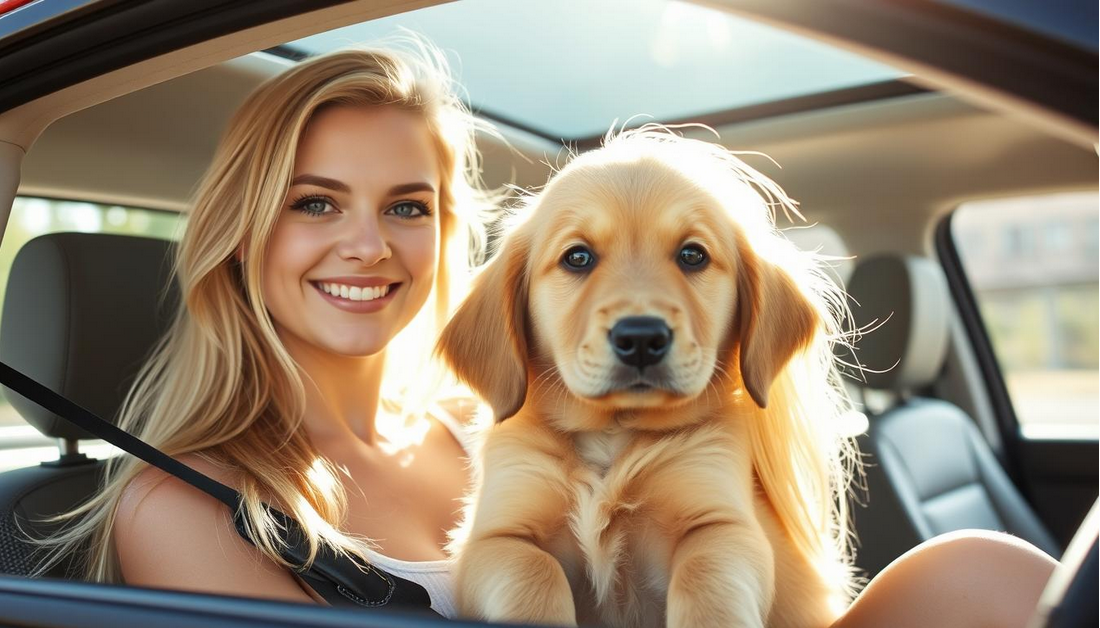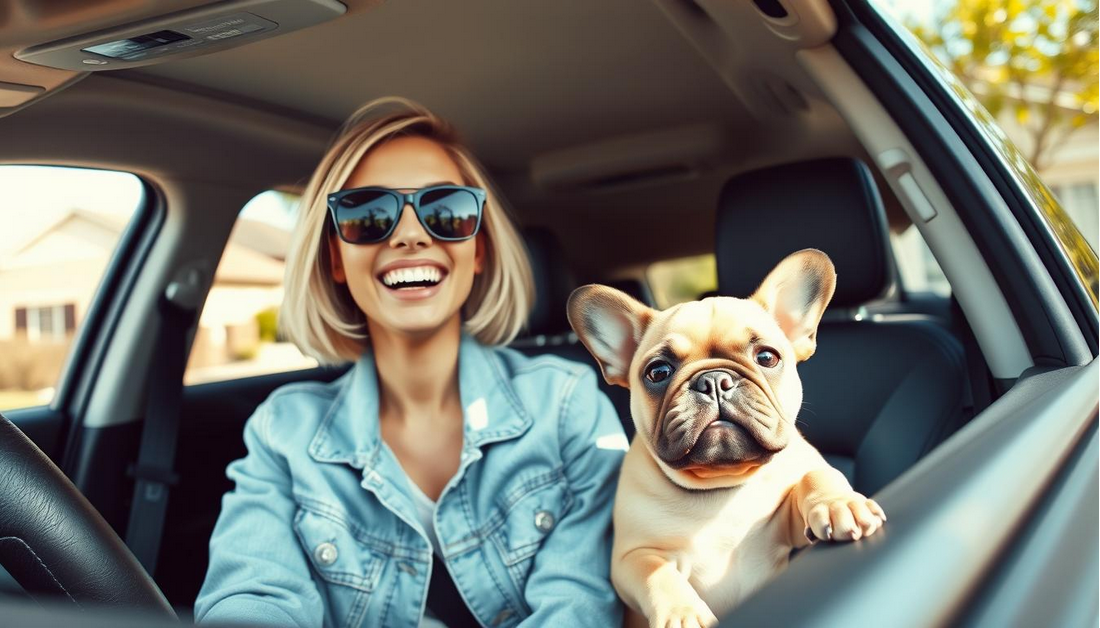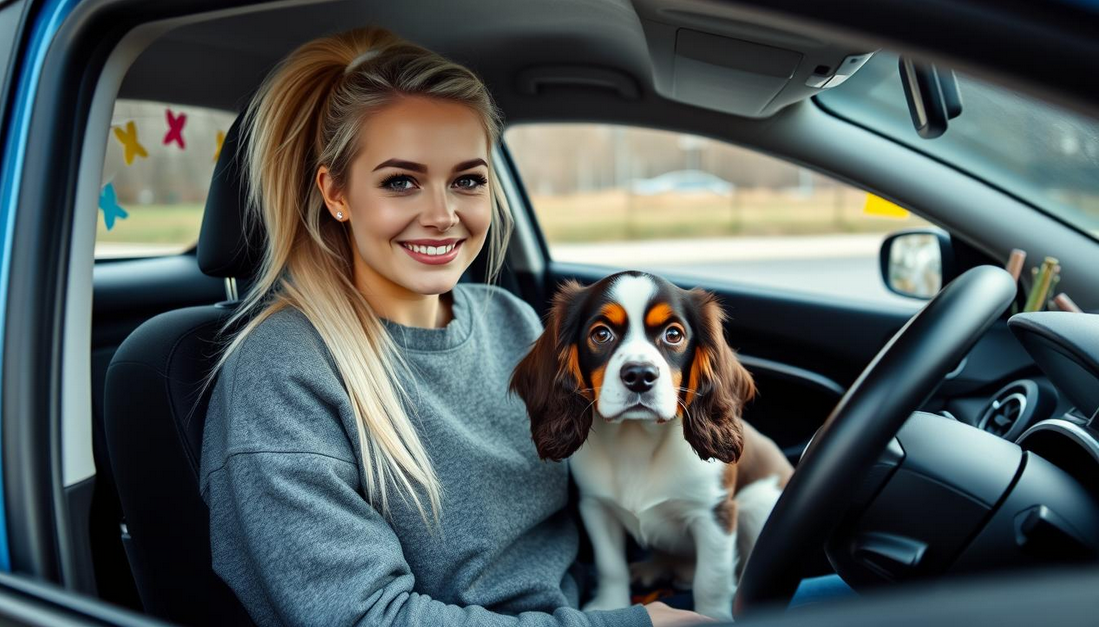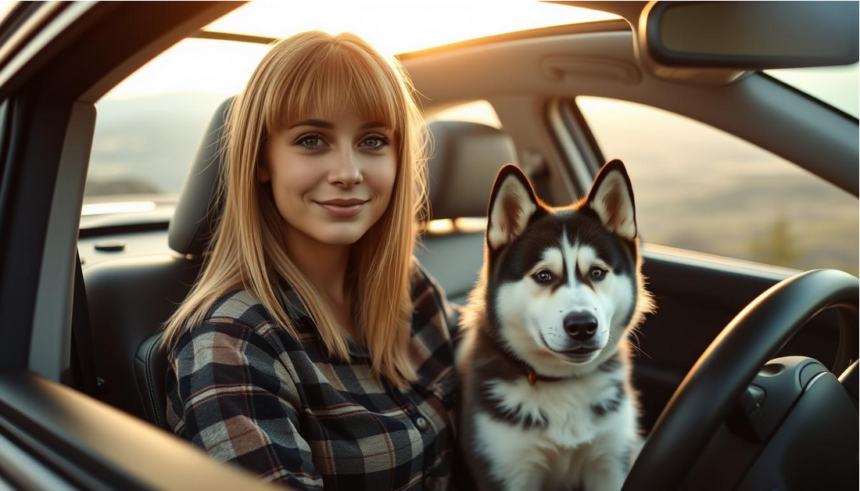India customers to view on amazon.in
7 Ways to Calm Dogs During Car Rides
Traveling with your furry friend can be a delightful experience, but for many dogs, car rides can be a source of significant stress. Dog anxiety in cars is a common issue that can make journeys uncomfortable for both pets and their owners.
- Understanding Dog Anxiety During Car Travel
- The Importance of Car Ride Preparation
- 7 Ways to Calm Dogs During Car Rides
- Technique1: Creating a Comfortable Safe Space
- Selecting the Right Crate or Carrier
- Using Familiar Bedding and Toys
- Proper Positioning in the Vehicle
- Technique2: Gradual Desensitization Training
- Technique3: Calming Products and Accessories
- Technique4: Creating a Soothing Environment
- Technique5: Addressing Motion Sickness
- Identifying Symptoms of Car Sickness
- Natural Remedies for Motion Sickness
- When to Consult Your Vet About Medication
- Technique6: Strategic Breaks and Reward Systems
- Technique7: Maintaining Calm Owner Energy
- Safety Considerations for Traveling with Dogs
- Conclusion: Making Every Car Ride a Positive Experience
- FAQ
- What are the common signs of car anxiety in dogs?
- How can I help my dog feel more comfortable during car rides?
- What are some effective calming products for dogs during car travel?
- How can I prevent motion sickness in my dog during car travel?
- Why is it essential to maintain calm owner energy during car travel with dogs?
- What safety considerations should I keep in mind when traveling with my dog?
- How can I make car rides less stressful for my dog?
- Can gradual desensitization training help my dog overcome car anxiety?

Understanding the root causes of this anxiety is crucial to creating a more enjoyable travel experience. In this article, we’ll explore effective techniques to calm your dog during car rides, ensuring a smoother journey for all.
Key Takeaways
- Understand the causes of dog anxiety during car rides
- Learn effective techniques to calm your dog
- Discover the benefits of calming treats for dogs in cars
- Explore ways to reduce dog car anxiety
- Create a comfortable travel environment for your pet
Understanding Dog Anxiety During Car Travel
Car rides can be a source of significant stress for dogs, and understanding this anxiety is key to making travel more enjoyable for both pets and their owners. Dog anxiety during car travel manifests in various ways, and recognizing these signs is the first step towards addressing the issue.
Common Signs of Car Anxiety in Dogs
Dogs exhibit anxiety in different forms. Common signs include panting, pacing, whining, and restlessness. Some dogs may even display more severe reactions such as vomiting or attempting to escape from the vehicle. It’s crucial to identify these signs early to intervene effectively.
| Signs of Anxiety | Description |
|---|---|
| Panting | Rapid breathing, often accompanied by drooling. |
| Pacing | Restless movement within the vehicle. |
| Whining | High-pitched sounds indicating distress. |
Why Dogs Get Stressed in Vehicles
Dogs can get stressed in vehicles due to various factors, including unfamiliar environments, motion sickness, or past traumatic experiences. Understanding the root cause of your dog’s anxiety is essential to finding the right solution. For instance, if your dog suffers from motion sickness, you may need to explore remedies or consult with a veterinarian.

By acknowledging the causes and signs of dog anxiety during car travel, you can begin to work on strategies to calm your dog, making car rides less stressful for both of you.
The Importance of Car Ride Preparation
A well-prepared dog is a happy traveler, and it all starts before you hit the road. Preparing your dog for a car ride involves several steps that can significantly reduce their anxiety and make the journey more enjoyable for both you and your pet.
One crucial aspect of preparation is ensuring your dog is adequately exercised before the trip. Pre-trip exercise routines can help burn off excess energy, making your dog more relaxed during the car ride.
Pre-Trip Exercise Routines
Engaging your dog in physical activity before traveling can help reduce anxiety. A tired dog is a happy dog, and a good walk or playtime can make a significant difference in their behavior during the car ride. Aim for at least 30 minutes of exercise to help your dog relax.
Feeding Guidelines Before Travel
It’s also important to consider feeding guidelines before travel. Avoid feeding your dog a large meal immediately before the trip to prevent discomfort or motion sickness. Instead, opt for a light meal a few hours before traveling, and ensure your dog has access to water to stay hydrated.
Essential Items for Stress-Free Travel
Packing essential items for stress-free travel can provide comfort and reassurance for your dog. These may include their favorite toys, a familiar blanket, and any necessary medication. Having these items readily available can help calm your dog during the journey.
By following these preparation tips, you can create a more enjoyable and stress-free car ride experience for your dog. Remember, a well-prepared dog is a happy traveler.

7 Ways to Calm Dogs During Car Rides
Dogs often experience anxiety during car travel, but there are several techniques to help calm them. Car rides can be a source of stress for many dogs, leading to a range of anxious behaviors. Fortunately, by understanding and implementing effective calming strategies, you can make car travel a more pleasant experience for your pet.
Overview of Effective Calming Techniques
There are multiple approaches to calming dogs during car rides, each addressing different aspects of their anxiety. Creating a comfortable environment is crucial, as it helps your dog feel secure and relaxed. This can involve using familiar bedding or toys that provide a sense of comfort.
Gradual desensitization training is another effective technique. By gradually introducing your dog to the car and making the experience positive, you can reduce their anxiety over time. This process involves starting with small steps, such as simply being near the car, then progressing to being inside it, and eventually going for a ride.

Various calming products and accessories are available, including anxiety vests, calming treats, and pheromone diffusers. These tools can be highly effective in reducing your dog’s stress levels during car travel. Additionally, creating a soothing environment within the vehicle, such as maintaining a comfortable temperature and playing calming music, can also help.
Other techniques include strategic breaks and reward systems, which involve planning regular stops during long trips and rewarding your dog for calm behavior. Maintaining calm owner energy is also important, as dogs can pick up on their owner’s stress, making it essential for owners to remain calm during car rides.
By exploring these different techniques and finding what works best for your dog, you can significantly reduce their car ride anxiety. Whether it’s through environmental changes, training, or the use of calming aids, there are numerous ways to make car travel less stressful for your pet.
Technique1: Creating a Comfortable Safe Space
One effective technique for calming dogs during car travel is creating a comfortable safe space. This involves making your dog feel secure and relaxed in their environment, reducing anxiety during car rides.

Selecting the Right Crate or Carrier
Choosing the right crate or carrier is crucial for creating a safe space for your dog. The crate should be well-ventilated, sturdy, and the right size for your dog to stand up, turn around, and lie down comfortably. A crate specifically designed for car travel can help reduce your dog’s anxiety by providing a sense of security and stability.
Using Familiar Bedding and Toys
Adding familiar bedding and toys to the crate can make your dog feel more at ease. Bringing along your dog’s favorite blanket or toy can provide comfort and reassurance during the car ride. This familiarity can help calm your dog’s nerves and make the travel experience less stressful.
Proper Positioning in the Vehicle
Proper positioning of the crate within the vehicle is also important. The crate should be securely positioned to prevent it from moving during the car ride. Placing the crate in a stable location, such as the back seat or cargo area, can help reduce your dog’s anxiety by minimizing movement and distractions.
By following these steps, you can create a comfortable and safe space for your dog, making car rides less stressful for both you and your pet.
- Choose a well-ventilated crate or carrier
- Add familiar bedding and toys
- Position the crate securely in the vehicle
Technique2: Gradual Desensitization Training
Gradual desensitization training is a highly effective method for helping dogs become comfortable with car travel. This technique involves a systematic approach to acclimating your dog to the vehicle, reducing anxiety and stress associated with car rides.

Step-by-Step Car Acclimation Process
The key to successful gradual desensitization training lies in its step-by-step approach. Begin by letting your dog explore the car while it’s stationary. Encourage them to enter the vehicle voluntarily by using treats and praise.
- Start with the doors open to create a comfortable environment.
- Gradually increase the time your dog spends inside the car.
- Once they’re comfortable inside, start the engine while they’re in the car, beginning with short sessions.
Building Positive Associations with Vehicles
Building positive associations is crucial in helping your dog view the car as a welcoming space. Use your dog’s favorite treats and toys to create a positive link with the vehicle.
- Place treats inside the car to entice your dog to enter.
- Reward your dog for calm behavior while in the car.
- As your dog becomes more comfortable, you can progress to short drives, continuing to reward calm behavior.
By following these steps and being patient with your dog’s progress, you can significantly reduce their car anxiety. Consistency and positive reinforcement are key to the success of gradual desensitization training.
Technique3: Calming Products and Accessories
Dog anxiety during car rides can be effectively managed with the help of specialized calming products and accessories. These products range from anxiety vests and wraps to calming treats and pheromone products, all designed to provide relief to anxious dogs.
Anxiety Vests and Wraps
Anxiety vests and wraps work by applying gentle pressure to your dog’s body, providing a calming effect. This concept is based on the principle of deep pressure therapy, which has been shown to reduce anxiety in dogs. Products like the ThunderShirt or Anxiety Wrap are popular choices among dog owners. They are easy to use and can be adjusted to fit your dog comfortably.

Calming Treats and Supplements
Calming treats and supplements are another effective way to reduce your dog’s anxiety during car rides. These products typically contain natural ingredients such as L-theanine, chamomile, or valerian root, known for their calming properties. When choosing calming treats or supplements, it’s essential to consult with your veterinarian to ensure you’re selecting a product that’s safe and suitable for your dog.
| Product Type | Description | Key Ingredients |
|---|---|---|
| Anxiety Vests/Wraps | Provides gentle pressure for calming effect | N/A |
| Calming Treats | Natural ingredients for stress relief | L-theanine, Chamomile |
| Pheromone Products | Mimics natural calming scents for dogs | Dog Appeasing Pheromone (DAP) |
Pheromone Products for Travel
Pheromone products mimic the natural calming scents that mother dogs produce to comfort their puppies. These products come in various forms, including diffusers, sprays, and collars. Adaptil is a well-known brand offering pheromone-based solutions for anxious dogs. Using pheromone products during car rides can create a more comforting environment for your dog, reducing their anxiety and stress.
By incorporating these calming products and accessories into your car travel routine, you can significantly reduce your dog’s anxiety, making the journey more enjoyable for both you and your pet.
Technique4: Creating a Soothing Environment
To ease your dog’s car anxiety, it’s essential to create a peaceful environment. A calm atmosphere in the vehicle can significantly impact your dog’s comfort level, making the travel experience more enjoyable for both you and your pet.
Temperature and Ventilation Control
Maintaining a comfortable temperature and ensuring proper ventilation are crucial for your dog’s comfort during car rides. Avoid extreme temperatures that can cause discomfort or stress. Ensure that the air is fresh and circulating well to prevent your dog from feeling claustrophobic or overheated.
A simple adjustment in temperature can make a significant difference. For instance, keeping the car at a comfortable temperature can help reduce your dog’s anxiety.
Music and White Noise Solutions
Playing calming music or white noise can be an effective way to distract your dog from stressful stimuli during car rides. Calming music specifically designed for dogs can help reduce anxiety, while white noise can mask other disturbing sounds.
Some popular options include:
- Calming dog music playlists
- White noise machines or apps
- Nature sounds
Scent Therapy for Car Rides
Scent therapy is another technique that can help create a calming environment for your dog. Certain scents, such as lavender or chamomile, are known for their calming effects. You can use a diffuser or apply a calming spray to your dog’s bedding or in the car.
A study found that scent therapy can significantly reduce stress and anxiety in dogs. By incorporating scent therapy into your car rides, you can create a more relaxing atmosphere for your pet.
| Technique | Description | Benefits |
|---|---|---|
| Temperature Control | Maintaining a comfortable temperature | Reduces stress caused by extreme temperatures |
| Music and White Noise | Playing calming music or white noise | Distracts from stressful stimuli, reduces anxiety |
| Scent Therapy | Using calming scents like lavender or chamomile | Creates a calming atmosphere, reduces stress |

Technique5: Addressing Motion Sickness
Addressing motion sickness is crucial for making car travel more enjoyable for dogs. Motion sickness can cause significant discomfort, leading to a stressful experience for both pets and their owners.
Recognizing the signs of motion sickness early can help in managing the condition effectively. Common symptoms include drooling, restlessness, and vomiting.
Identifying Symptoms of Car Sickness
It’s essential to identify the symptoms of car sickness in dogs to provide timely relief. Some common indicators include:
- Drooling or excessive salivation
- Restlessness or agitation
- Vomiting or retching
- Lack of appetite before or during travel
Natural Remedies for Motion Sickness
Several natural remedies can help alleviate motion sickness in dogs. These include:
- Ginger-based products, known for their soothing effects
- Dietary changes, such as feeding a light meal before travel
- Pheromone products that calm the dog
- Calming treats or supplements recommended by a veterinarian

When to Consult Your Vet About Medication
If your dog experiences severe motion sickness, consulting with your veterinarian about potential medication is advisable. They can recommend the most suitable options based on your dog’s health and history.
Prevention and timely intervention are key to managing motion sickness. By understanding the symptoms and exploring natural remedies or veterinary advice, you can make car travel a more pleasant experience for your dog.
Technique6: Strategic Breaks and Reward Systems
To further alleviate your dog’s anxiety during car rides, it’s essential to incorporate strategic breaks and reward systems into your travel routine. Regular breaks can help reduce your dog’s stress by providing opportunities for exercise, relaxation, and mental rejuvenation.

Planning Rest Stops for Anxious Dogs
When planning rest stops, consider locations with minimal distractions and plenty of space for your dog to move around. Pet-friendly parks or quiet parking areas are ideal. During these breaks, allow your dog to stretch, exercise, and relieve themselves. This can significantly reduce anxiety and make the remainder of the trip more enjoyable.
- Choose pet-friendly stops with minimal distractions.
- Allow your dog to exercise and relieve themselves.
- Keep breaks consistent to establish a routine.
Positive Reinforcement During Travel
Implementing a positive reinforcement system during travel can encourage good behavior and reduce anxiety. Reward your dog with treats, praise, and affection during and after rest stops. This positive association can help your dog view car travel more favorably.
By incorporating strategic breaks and positive reinforcement into your dog’s travel routine, you can make car rides less stressful and more enjoyable for your pet.
Technique7: Maintaining Calm Owner Energy
Your calm energy as a dog owner can be a powerful tool in soothing your dog’s anxiety during car rides. The behavior and energy you exhibit while driving can significantly influence your dog’s comfort level and stress response.
How Your Behavior Affects Your Dog
Dogs are highly attuned to their owner’s emotions and behaviors. When you’re calm and relaxed, your dog is more likely to feel the same way. Conversely, if you’re stressed or anxious, your dog may pick up on those cues and become anxious as well. By being mindful of your behavior and maintaining a calm demeanor, you can help create a more peaceful environment for your dog during car travel.
Techniques for Staying Relaxed During Travel
To stay relaxed during car rides with your dog, try techniques such as deep breathing exercises or listening to calming music. Being aware of your reactions to driving and taking steps to manage your stress can also help. By staying calm, you’ll not only improve your own travel experience but also contribute to a more comfortable ride for your dog.
Safety Considerations for Traveling with Dogs
When traveling with your dog, safety should be your top priority. Ensuring your dog’s safety during car rides involves several key considerations to prevent injuries and ensure a smooth journey.
One of the most critical aspects of dog car safety is the use of proper restraint systems. Just like humans, dogs need to be securely fastened in to prevent injury during sudden stops or accidents.
Proper Restraint Systems
There are several types of restraint systems available for dogs, including harnesses, crates, and carriers. The choice of restraint depends on the size and temperament of your dog, as well as your vehicle’s configuration.
| Restraint Type | Description | Suitable For |
|---|---|---|
| Harnesses | Attach to the car’s seatbelt system, providing a secure and comfortable fit. | Dogs of various sizes, especially those who are anxious or prone to escaping. |
| Crates | Provide a safe space for your dog, protecting them from injury and reducing anxiety. | Dogs who are crate-trained, or those who feel secure in enclosed spaces. |
| Carriers | Soft-sided or hard-sided carriers that can be secured with a seatbelt. | Small to medium-sized dogs, or those who prefer enclosed spaces. |
Emergency Preparedness for Dog Travel
In addition to proper restraint, being prepared for emergencies is crucial. This includes having a first-aid kit specifically designed for dogs, knowing basic first aid, and having a plan for emergency veterinary visits.
Some essential items to include in your dog’s travel first-aid kit are bandages, antiseptic wipes, tweezers, and any medications your dog may need. It’s also a good idea to keep a list of emergency contact numbers, including your veterinarian and the nearest animal hospital along your route.
Conclusion: Making Every Car Ride a Positive Experience
By implementing the seven techniques outlined in this article, you can transform car rides into a more positive experience for your dog. Understanding and addressing anxiety, creating a soothing environment, and ensuring safety are crucial steps towards stress-free dog travel.
With patience and consistency, you can help your dog look forward to car rides, making every journey an enjoyable adventure for both of you. By following these dog travel tips, you can reduce your dog’s car anxiety and create a relaxing atmosphere for your dog during drives.
Effective dog car anxiety solutions involve a combination of preparation, the right products, and a calm owner energy. By putting these strategies into practice, you can make car rides positive for dogs and enjoy stress-free travel together.
FAQ
What are the common signs of car anxiety in dogs?
Common signs of car anxiety in dogs include panting, pacing, whining, vomiting, and attempting to escape. Recognizing these signs is crucial to addressing your dog’s anxiety.
How can I help my dog feel more comfortable during car rides?
To help your dog feel more comfortable, you can create a safe space, use gradual desensitization training, utilize calming products, and ensure a soothing environment. Each dog is different, so it may take some trial and error to find what works best.
What are some effective calming products for dogs during car travel?
Effective calming products include anxiety vests and wraps, calming treats and supplements, and pheromone products. These products can help alleviate your dog’s anxiety and make car rides more enjoyable.
How can I prevent motion sickness in my dog during car travel?
To prevent motion sickness, identify symptoms early, and consider natural remedies like ginger or dietary changes. In severe cases, consult with your veterinarian about potential medication.
Why is it essential to maintain calm owner energy during car travel with dogs?
As a dog owner, your energy and behavior significantly impact your dog’s anxiety levels. Maintaining a calm demeanor can help your dog feel more at ease, creating a more peaceful environment.
What safety considerations should I keep in mind when traveling with my dog?
Ensure your dog’s safety by using proper restraint systems, such as harnesses or crates, and being prepared for emergencies with a first-aid kit and a plan for emergency veterinary visits.
How can I make car rides less stressful for my dog?
To make car rides less stressful, prepare your dog in advance with pre-trip exercise routines, create a comfortable environment, and consider the seven techniques outlined in this article to address various aspects of dog anxiety.
Can gradual desensitization training help my dog overcome car anxiety?
Yes, gradual desensitization training is a powerful technique to help your dog become more comfortable with car travel. It involves a step-by-step process of acclimating your dog to the vehicle, building positive associations, and reducing anxiety.







